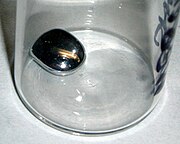Cohesion (chemistry)
This article needs additional citations for verification. (March 2010) |

Cohesion (n. lat. cohaerere "stick or stay together") or cohesive attraction or cohesive force is a physical property of a substance, caused by the intermolecular attraction between like-molecules within a body or substance that acts to unite them. Basically, the action of molecules of the same atomic structure sticking together is called cohesion.

Water, for example, is strongly cohesive as each molecule may make four hydrogen bonds to other water molecules in a tetrahedral configuration. This results in a relatively strong Coulomb force between molecules. Van der Waals gases such as methane, however, have weak cohesion due only to Van der Waals forces that operate by induced polarity in non-polar molecules.
Cohesion, along with adhesion (attraction between unlike molecules), helps explain phenomena such as meniscus, surface tension and capillary action.
Mercury in a glass flask is a good example of the effects of the ratio between cohesive and adhesive forces. Because of its high cohesion and low adhesion to the glass, mercury does not spread out to cover the bottom of the flask, and if enough is placed in the flask to cover the bottom, it exhibits a strongly convex meniscus, where the meniscus of water is concave . Mercury will not wet the glass, unlike water and many other liquids,[1] and if the glass is tipped, it will 'roll' around inside.
See also
External links
- The Bubble Wall (Audio slideshow from the National High Magnetic Field Laboratory explaining cohesion, surface tension and hydrogen bonds)
